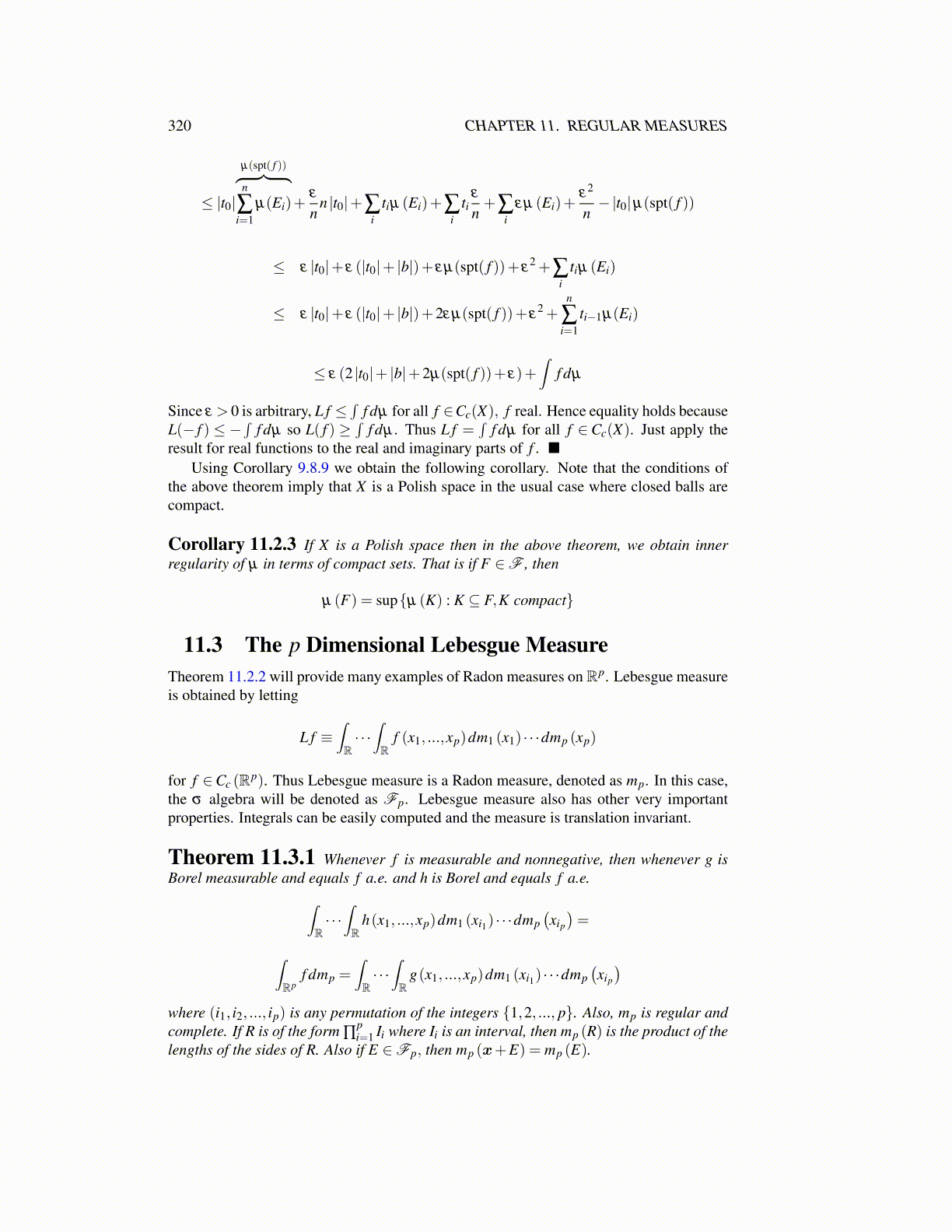
320 CHAPTER 11. REGULAR MEASURES
≤ |t0|
µ(spt( f ))︷ ︸︸ ︷n
∑i=1
µ(Ei)+ε
nn |t0|+∑
itiµ (Ei)+∑
iti
ε
n+∑
iεµ (Ei)+
ε2
n−|t0|µ(spt( f ))
≤ ε |t0|+ ε (|t0|+ |b|)+ εµ(spt( f ))+ ε2 +∑
itiµ (Ei)
≤ ε |t0|+ ε (|t0|+ |b|)+2εµ(spt( f ))+ ε2 +
n
∑i=1
ti−1µ(Ei)
≤ ε (2 |t0|+ |b|+2µ(spt( f ))+ ε)+∫
f dµ
Since ε > 0 is arbitrary, L f ≤∫
f dµ for all f ∈Cc(X), f real. Hence equality holds becauseL(− f ) ≤ −
∫f dµ so L( f ) ≥
∫f dµ . Thus L f =
∫f dµ for all f ∈ Cc(X). Just apply the
result for real functions to the real and imaginary parts of f . ■Using Corollary 9.8.9 we obtain the following corollary. Note that the conditions of
the above theorem imply that X is a Polish space in the usual case where closed balls arecompact.
Corollary 11.2.3 If X is a Polish space then in the above theorem, we obtain innerregularity of µ in terms of compact sets. That is if F ∈F , then
µ (F) = sup{µ (K) : K ⊆ F,K compact}
11.3 The p Dimensional Lebesgue MeasureTheorem 11.2.2 will provide many examples of Radon measures on Rp. Lebesgue measureis obtained by letting
L f ≡∫R· · ·∫R
f (x1, ...,xp)dm1 (x1) · · ·dmp (xp)
for f ∈Cc (Rp). Thus Lebesgue measure is a Radon measure, denoted as mp. In this case,the σ algebra will be denoted as Fp. Lebesgue measure also has other very importantproperties. Integrals can be easily computed and the measure is translation invariant.
Theorem 11.3.1 Whenever f is measurable and nonnegative, then whenever g isBorel measurable and equals f a.e. and h is Borel and equals f a.e.∫
R· · ·∫R
h(x1, ...,xp)dm1 (xi1) · · ·dmp(xip
)=
∫Rp
f dmp =∫R· · ·∫R
g(x1, ...,xp)dm1 (xi1) · · ·dmp(xip
)where (i1, i2, ..., ip) is any permutation of the integers {1,2, ..., p}. Also, mp is regular andcomplete. If R is of the form ∏
pi=1 Ii where Ii is an interval, then mp (R) is the product of the
lengths of the sides of R. Also if E ∈Fp, then mp (x+E) = mp (E).